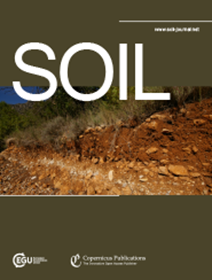Luminescence dating approaches to reconstruct the formation of plaggic anthrosols
IF 5.8
2区 农林科学
Q1 SOIL SCIENCE
引用次数: 0
Abstract
Abstract. Plaggic anthrosols demonstrate the significant and widespread influence of agriculture on the landscape of northern Europe and testify to increased land-use intensity over the last millennium. However, a lack of established chronologic methods to interrogate these soils has hindered research on their formation history, so the timing and process of plaggic anthrosol development remain poorly quantified. Recently, luminescence dating methods have emerged as a tool for tracing the past movement of grains, including within the soil column. This study combines two primary luminescence methods – single-grain feldspar infrared stimulated luminescence (IRSL) along with post-infrared infrared stimulated luminescence (pIRIR) measurements and small-aliquot (or multi-grain) quartz optically stimulated luminescence (OSL) – to reconstruct the formation of a plaggic anthrosol at Braakmankamp (eastern Netherlands). Toward this aim, we present a new method to identify well-bleached single grains of feldspar using the ratio of the grain's IRSL and pIRIR signals as a filter. The results provide both methodological and applied archaeological insights. Both small-aliquot quartz OSL and single-grain feldspar pIRIR ages yield reliable ages for plaggen deposits when the new filtering approach is used to remove poorly bleached feldspar grains from the analysis. Single-grain pIRIR feldspar has the added benefit of revealing complex soil formation histories for naturally bioturbated deposits, including those at the base of the plaggen layer. Augmenting this information with conventional quartz OSL dating builds confidence in the geo-chronologic record and allows us to reconstruct the timing and processes of plaggic anthrosol formation in Braakmankamp. According to the luminescence dating results, land clearance occurred around 900–1000 years ago, and accumulation of plaggen material began around 700–800 years ago. The average accumulation rate of plaggen material is estimated at ∼ 1.1 mm yr−1.用发光测年法重建块状炭溶胶的形成过程
摘要。Plaggic anthrosols 显示了农业对北欧景观的重要而广泛的影响,并证明了在过去的一千年中土地使用强度的增加。然而,由于缺乏成熟的年代学方法来研究这些土壤,阻碍了对其形成历史的研究,因此,对plaggic anthrosol形成的时间和过程的量化程度仍然很低。最近,发光测年法作为一种工具出现,可用于追踪颗粒过去的移动,包括在土壤柱内的移动。本研究结合了两种主要的发光方法--单晶粒长石红外激发发光(IRSL)以及后红外激发发光(pIR)测量和小等比(或多晶粒)石英光学激发发光(OSL)--来重建 Braakmankamp(荷兰东部)地层岩溶的形成过程。为此,我们提出了一种新方法,利用长石晶粒的 IRSL 和 pIRIR 信号的比值作为滤光器,来识别漂白良好的单个长石晶粒。研究结果提供了方法论和应用考古学方面的启示。当使用新的过滤方法从分析中剔除漂白不良的长石颗粒时,小当量石英OSL和单颗粒长石pIRIR年龄都能为plaggen沉积提供可靠的年龄。单粒长石红外光谱分析的另一个好处是可以揭示天然生物扰动沉积物(包括 plaggen 层底部的沉积物)复杂的土壤形成历史。用传统的石英 OSL 测定法来补充这一信息,可以增强我们对地质年代记录的信心,并使我们能够重建布拉克曼坎普的钙钛矿形成时间和过程。根据发光测年结果,土地清理发生在大约 900-1000 年前,而 plaggen 物质的堆积开始于大约 700-800 年前。Plaggen 物质的平均积累率估计为 1.1 毫米/年-1。
本文章由计算机程序翻译,如有差异,请以英文原文为准。
求助全文
约1分钟内获得全文
求助全文
来源期刊

Soil
Agricultural and Biological Sciences-Soil Science
CiteScore
10.80
自引率
2.90%
发文量
44
审稿时长
30 weeks
期刊介绍:
SOIL is an international scientific journal dedicated to the publication and discussion of high-quality research in the field of soil system sciences.
SOIL is at the interface between the atmosphere, lithosphere, hydrosphere, and biosphere. SOIL publishes scientific research that contributes to understanding the soil system and its interaction with humans and the entire Earth system. The scope of the journal includes all topics that fall within the study of soil science as a discipline, with an emphasis on studies that integrate soil science with other sciences (hydrology, agronomy, socio-economics, health sciences, atmospheric sciences, etc.).
 求助内容:
求助内容: 应助结果提醒方式:
应助结果提醒方式:


